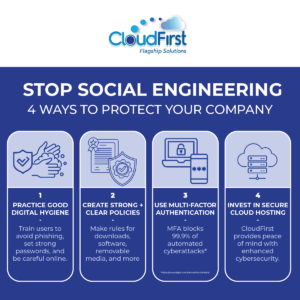We’re all used to the obvious robocalls that leave tons of voicemails and the spam emails that clog up our inboxes. But if you’re a business owner, you aren’t always prepared when a senior manager receives an email from someone posing as you or a compelling link supposedly sent out by HR leads to powerful, fast-acting malware.
This is called social engineering, and it’s a real danger that can send your business into a crisis. If you aren’t equipped with the proper knowledge and tools to tackle social engineering when it inevitably targets your business, then you’re only a click away from being robbed of your time, your money, and even your reputation.
What is social engineering?
Carnegie Mellon University describes social engineering as “the tactic of manipulating, influencing, or deceiving a victim in order to gain control over a computer system, or to steal personal and financial information.”
Basically, social engineering is hacking by way of deception rather than technology.
This definition alone demonstrates why social engineering can be dangerous for your business. Still, it can get even more problematic than that.
Social engineering usually involves:
- psychological manipulation
- the perpetrator tricking the user into giving away sensitive information
- the user making errors that could jeopardize security
This manipulation can even be threatening, putting the user in a challenging spot where they feel trapped and have no choice but to do what the manipulator says.
Different types of social engineering

Social engineering comes in many forms, each requiring different approaches and analyses to prevent.
Let’s look into the details of the most common forms so you can quickly identify these situations before they spiral out of control.
Phishing
Phishing emails and phone calls have been around as long as the technology they exploit has been in use. It’s a blanket term for many types of social engineering that generally refers to using emails that look authentic enough to lure a person into divulging personal or sensitive information. But just because it’s a basic type of social engineering doesn’t mean it can’t devastate your company.
There’s a reason this approach has such staying power: it works.
Phishing is also getting more sophisticated as time progresses, with the vocabulary scammers use being more convincing and the malware you click on being faster and more destructive than ever.
Spear phishing
While phishing involves attackers casting a wide net to see what they can rake in, spear phishing targets a specific individual.
The perpetrators often have detailed information they can use against this person. They might include personal details to sound more legitimate or impersonate someone the individual knows, like their boss, to earn trust.
Spoofing is a convincing tactic attackers use to falsify a phone number or email address, hiding their identity behind a more trustworthy alternative. The Federal Communications Commission (FCC) recommends never giving out personal information over the phone to prevent yourself from becoming a spoofing statistic.
Whaling
Social engineers who whale have one goal: to catch the big one. The veritable Moby Dick of cybersecurity scenarios targets senior managers, VPs, executives, and other leaders.
While these targets will likely have more background in handling social engineering, the attackers have this in mind and adjust their approach accordingly, using harder-to-spot techniques like email spoofing. And since these employees have higher access to sensitive data, catching a whale can completely uproot a company and cause chaos.
Stolen credentials
Attackers can use multiple angles to steal passwords, but many turn to social engineering to do so. This can be through phishing, spear phishing, or whaling.
Still, the attacker’s primary goal in getting the user to share usernames and passwords is to gain access to highly sensitive information.
Physical attacks
Probably the most nefarious example of social engineering is when someone shows up to your company as a Trojan horse.
These physical attacks often involve someone claiming they’re on site to fix something IT related. They might even be wearing a reflective vest and a hard hat to truly sell the illusion. And with enough confidence and no guardrails in place, many people would assume they’re telling the truth and let them into a data center or server room, giving them free rein over the most vulnerable part of your business.
How to spot social engineering
All social engineering attacks have a common denominator. There’s some form of bait to entice the target to engage with the scam. The Cybersecurity and Infrastructure Security Agency (CISA) Phishing Campaign Assessments revealed that 84% of all employees take the bait within the first ten minutes of receiving a malicious email, either by interacting with links or by offering sensitive information.
What makes the bait so tempting? CISA discovered which subject lines get the most attention when social engineering comes in the form of an email:
- any alerts specific to the user, including ones that mention personal information
- companywide general announcements or updates
- updates to an individual’s financial situation and security
Before you take the bait, there are some precautions you can take to confirm that the email or link is legit:
- Examine the sender and the email contents. Social engineering emails often have suspicious messaging that can give them away as fake.
- Do a gut check. Look for grammar and spelling mistakes, which are common in phishing emails.
- Avoid clicking links in suspicious emails, even if they say they’re to “remove” or “unsubscribe” you from a list.
- Avoid providing personal or sensitive information to email addresses or people you aren’t familiar with.
- Use anti-phishing features on your email client and web browser.
Regardless, it’s a dual endeavor between the individual and the company to stay well informed on how social engineering can manifest.
How can you protect yourself from social engineering?

With a better idea of what social engineering is and the different ways you could fall victim to it, it’s time to look at some actionable tips on how to prevent you and your business from becoming a statistic.
Practice good digital hygiene
Train employees on proper digital hygiene practices. This includes teaching employees to use strong passwords and update them regularly, consistently updating electronic devices to patch vulnerabilities, and using cybersecurity measures like multi-factor authentication (MFA) to access sensitive information.
Create strong, clear policies surrounding technology
Have a clear guide on what is and isn’t okay to download from the internet. Software programs should be an immediate no-go; these files are the most likely to contain malware.
Still, attackers are getting wiser and more innovative by the second, so it’s safer to assume that nothing is safe until proven otherwise.
Use MFA whenever possible
Even the most complex passwords can be weak in the face of newer malware programs. The easiest way to fortify password protection is through multi-factor authentication (MFA). This authentication process involves requiring a user to pass multiple checks to log in, which will help manage risk.
You’ve probably seen this before on websites that hold your personal information; they usually ask you to enter a code you receive as a text. However, more elaborate processes can use biometrics, such as scanning a fingerprint, to confirm you are who you say you are.
Invest in secure storage solutions
Consider technology like email filters, password managers, and other cybersecurity measures to be the moat that keeps the Trojan horse at bay. You can train the guards at the gate all you want, but sometimes it’s best to prevent attackers from ever approaching the castle wall.
Working with a trusted cloud provider gives you immediate peace of mind, knowing that so much of the effort required to manage and protect data centers and sensitive information is in the hands of industry cybersecurity professionals. It’s an invaluable approach that many businesses adopt to further protect their most precious data and resources.
Note that a robust cybersecurity plan isn’t a substitute for user training. The most secure companies understand the merit of investing in both, so remember to take as many preventive measures as possible and stay vigilant by developing new processes and training employees to identify potential social engineering attacks.
Protect your data with cloud hosting
The digital age is rife with opportunities for attackers to prey on the unknowing and unsuspecting. But with the proper precautions in place, you can strip these actors of their power and keep your business running smoothly.
And sometimes, it’s as simple as keeping your most delicate information tightly sealed away, protected by state-of-the-art cybersecurity.
Learn more about social engineering, cloud-based services, and how they relate to cybersecurity with CloudFirst! Download the ebook and arm yourself with the knowledge you need to win the battle for your business’s most valuable resources.

